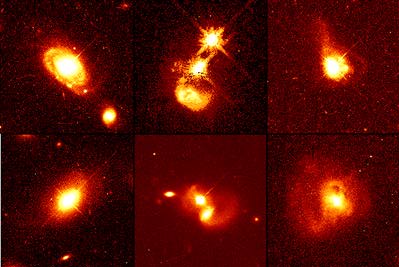The Ball-of-Light Particle Model predicts a Quasar is a decaying ball-of-light. For example, scientists have taken many images of Quasars with the Hubble Space Telescope. Some of the more famous images include:

Currently, astronomers are trying to explain these images in terms of galaxies colliding. The Ball-of-Light Particle Model predicts these objects are decaying. In the two middle images, the balls-of-light are undergoing "split" decay modes. (See also, the Splitting of the Antennae Galaxies.) The Quasars in the upper left, upper right, and lower right all appear to be undergoing some form of disk decay mode. The Quasar in the lower left appears to be undergoing a "fizzle" decay mode.
There are very few Quasars that are close to earth. Even the closest Quasars are not "close." However, the further back in time Quasars are observer, the more numerous they are -- up to a point. Some estimates place the age of the universe at about 13 billion years old. If this age is correct, then when the universe was about 2 billion years old -- or, at redshifts where z equal to about 3 -- the number of Quasars compare to now was thousands of times greater. Going back even further in time -- to an age where the universe was only 1 billion years old -- the number of Quasars drops off dramatically. Why?
The Ball-of-Light Particle Model predicts quasars where ejected from a more massive explosion. These very large balls-of-light traveled away from the source of the explosion at high speeds. As they slowed, they became less stable and started decaying at about the same point in the history of the universe. Thus, from an age of about 1 billion years old to an age of about 4 billion years old, there was a great epoch of Quasar formation.
Scientists -- led by Peter Shaver (European Southern Observatory) -- have checked Quasar numbers by using radio wavelengths. These wavelengths can penetrate gas and dust. Their studies indicate the number of Quasars does drop off at distances greater than z = 3.
under construction